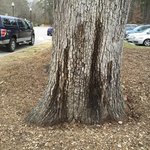bstewert
TreeHouser
Does anyone have a good article I can present to homeowners on proper mulching around the root flare on trees? I see it occasionally where the compost is piled up high. Shrubs, too.
Also, something on planting shrubs or trees right under the tree. Seems like not such a good idea to me. Here, our neighbor trenched into the root zone to put sprinklers, then planted three 6' baby firs under this 160' fir. These little grass shrubs are not so bad, I guess, but sometimes people will plant rhodys and such just a few feet from the base. It grows like that in the wild, so maybe it's OK?


Also, something on planting shrubs or trees right under the tree. Seems like not such a good idea to me. Here, our neighbor trenched into the root zone to put sprinklers, then planted three 6' baby firs under this 160' fir. These little grass shrubs are not so bad, I guess, but sometimes people will plant rhodys and such just a few feet from the base. It grows like that in the wild, so maybe it's OK?




